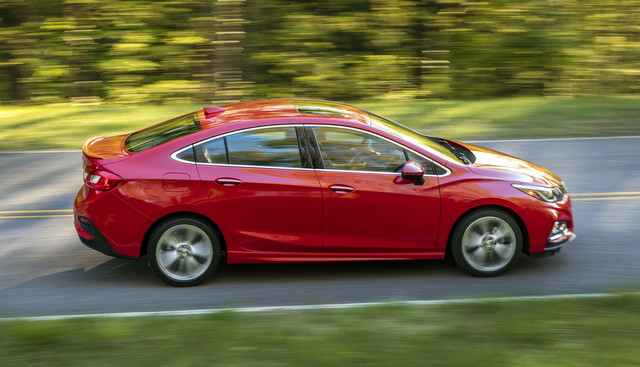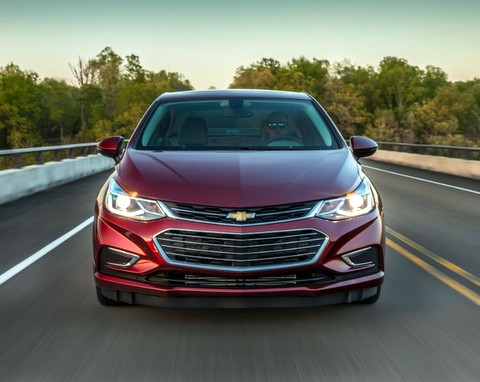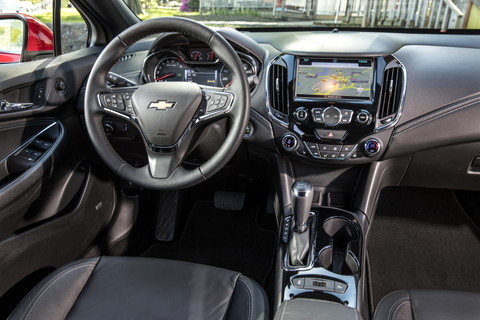Compact Sedan’s Swan Song
The Chevrolet Cruze is a compact sedan and hatchback with an interesting history. Now, it’s at the end of its American presence, with the closing of the Lordstown, Ohio, plant where it’s been made for U.S. consumption. The model’s impact is actually larger, as it’s been built and sold in other parts of the world—and still is.

I wasn’t planning to test a Cruze—and had never had the opportunity—but I got a chance recently when my Chevrolet Bolt EV was at the dealer for battery replacement surgery. The dealership handed me a key to a Summit White Cruze rental sedan. Although the Cruze doesn’t look much like a Bolt, it was comforting to carry an identical key in my pocket.
It Came from Korea
The Cruze started life as a Daewoo—the Korean company acquired by GM and that’s now known as GM Korea. The 2019 model is the second-generation design in the U.S. Interestingly, GM used GM Korea for much of the design of the Chevrolet Bolt, and the LG battery from the Bolt is Korea-sourced as well. So the Cruze and Bolt siblings both have Korean origins, but are built here. The Bolt is assembled exclusively in Orion County, Michigan.

The 2019 Cruze has some visual and content updates that made it look more like its American siblings, including the larger Malibu and Impala sedans. The front fascia, grille, and headlamps are fresh, as are the taillamps and wheels. There are also new interior colors and an updated entertainment center.
Offered in four levels—L, LS, LT, and Premier—the Cruze has served in the role of compact sedan that Chevy has offered for a long time. Think of the lineage—Corvair to Chevy II to Vega to Monza to Citation to Cavalier to Cobalt. It’s also related in mission and size to GM’s grand experiment of the 1990s—the defunct Saturn brand.
GM’s mainstream brand has offered economical transportation in the U.S. for half a century, but none of those names remain, and now the Cruze is joining them in the automotive history books.
The Modern Challenge for Sedans
Today, the hot property is SUVs—especially compact to midsize crossovers—and Chevrolet has a bunch of them, from the tiny Trax on up to the huge Suburban. It’s not hard to connect the dots. Instead of opting for the Cruze, a young family today might just go for an Equinox crossover instead. (Ed. note: The numbers bear this out; Equinox sales are more than three times those of Cruze for the first four months of 2019.)

So, how was my time with the Cruze? The interior looks well turned out, but materials are not fancy. The plastic panels are hard, but there was some cloth across part of the dash that felt nice. There is chrome sprinkled around the cabin, and plenty of styling and motion.
Mechanically, the car uses a 1.4-liter turbo four-cylinder engine matched with a six-speed automatic transmission. With 153 horsepower and 177 lb.-ft. of torque, and at just under a ton and a half, it’ll take you from 0 to 60 mph in 7.7 seconds. That’s not sports car territory, but you won’t feel bogged down either. You can hear the engine working, and the road is not completely insulated from the steering wheel, but overall, it’s easy to imagine driving a Cruze for years without great enthusiasm but with no complaints either.
Official EPA fuel economy ratings are 28 mpg city/38 highway/32 combined. My three-day mostly freeway test period earned me 26.2 mpg. The EPA Green numbers are 6 for Smog and 7 for Greenhouse Gas—good for SmartWay designation. Emitting 277 grams of CO2 per mile, this is a cleaner car than many other gasoline vehicles, and not much worse than a good hybrid.
Cruising in the Cruze
My Cruze test period included a weekend trip down to Monterey—a couple of hundred miles round-trip. While the driving experience was neither silent nor luxurious, the Cruze proved capable for freeway travel, and was maneuverable in town as well. There are more exciting cars around, but the overall competence explains why it has sold well for years in places like China and Australia.

You can pick up the base Cruze L sedan for less than $20,000, including shipping, which makes it kind of a bargain. My LT test car was better equipped, and came with the $1,200 Convenience Package, which includes keyless opening front doors, power dual outside mirrors (heated), power seats, keyless start, heated front seats, rear park assist, and two safety features—rear cross traffic alert and lane change alert with side blind zone alert. Its price was a reasonable $23,795.
The Cruze has served its time and delivered what customers needed. But today, as utility vehicles rise and sedans fall in the marketplace, its time is over. If you can find one left on a Chevy lot now, it should be a fine deal.
Related Stories You Might Enjoy—The Compact Competition (Shrinking, But Eclectic)
First Drive: 2020 Toyota Corolla Hybrid
Road Test: 2019 Toyota Corolla
Road Test: 2019 Kia Forte
5 Things About the 2018 Hyundai Accent
Road Test: 2018 Subaru Impreza
Road Test: 2017 Mazda3
Road Test: 2016 Ford Focus Electric
Road Test: 2016 Honda Civic
First Drive: 2016 Nissan Sentra
Road Test: 2016 Volkswagen Jetta

3 thoughts on “Road Test: 2019 Chevrolet Cruze”